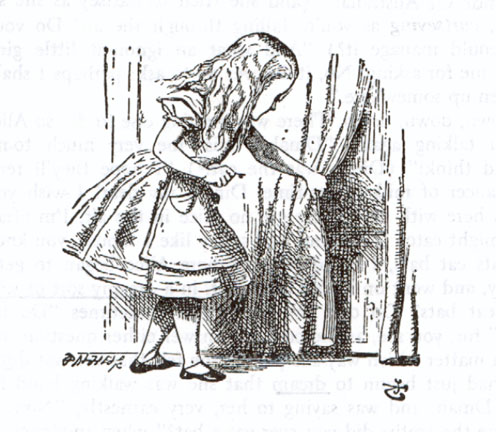Alice, key in hand, finds the door to Wonderland — Illustrations for Alice in Wonderland by John Tenniel (original) (raw)

Alice, key in hand, finds the door to Wonderland
Sir John Tenniel
1865
Wood-engraving by Dalziel
Illustration for the first chapter of Lewis Carroll's Alice in Wonderland
[See commentary below]
Student assistants from the University Scholars Program, National University of Singapore, scanned this image under the supervision of George P. Landow.
[You may use this image without prior permission for any scholarly or educational purpose as long as you (1) credit the site and (2) link your document to this URL in a web document or cite the Victorian Web in a print one.]
Commentary by Leighton Carter
Once Alice reaches the long hallway at the bottom of the rabbit-hole, the fantastical environment begins to exert its influence over her. She looses her ability to manipulate the objects that she encounters in any controlled, predictable way. Tenniel's pair of illustrations that portray Alice in front of the tiny door and then holding the bottle that commands "Drink Me" demonstrate the environment's active nature in Wonderland. In the first illustration, Alice pulls back a curtain to reveal the door that leads into "a small passage, not much larger than a rat hole." She holds the key expectantly in her hand, but the tiny door will not allow Alice to enter the garden. Tenniel dramatically inverts the usual difference in sizes between a child and a door and emphasizes Carroll's irony: Alice has a key (the only thing that is usually required for successfully entering a door in the real world) yet she cannot bodily walk through the door. This disparity between environment and body inverts the assumption that environments are made to support the body's wants (which Alice would likely hold as the child of a bourgeois British family). Wonderland then further changes the content of Alice's surroundings:
She went back to the table . . . this time she found a little bottle on it ("which certainly was not here before," said Alice), and tied around the neck of the bottle was a paper label, with the words "DRINK ME" beautifully printed on it in large letters. [Carroll 10]
Alice again applies her logic to the bottle — claiming that the bottle's contents are drinkable as long as it is not marked "poison" (she clearly did not learn the lesson of the orange marmalade). Tenniel's illustration shows Alice on the brink of drinking the liquid, confident in her stance that the bottle's contents will prove harmless. Although Alice thinks she controls her environment by means of logical investigation, this situation points out the fallacies inherent in her programmatic ways of thinking. The bottle's contents may eventually allow Alice to fulfill her wish to journey through the door, but she does not control her own progression to that desired end. Tenniel demonstrates Alice's false sense of control by presenting the tense position Alice often occupies in Wonderland: in both illustrations, she is pictured right before her grasp of the environment and its ground rules fails. [complete essay: ""Which way? Which way?": The Fantastical Inversions of Alice in Wonderland"]
Last modified 24 December 2007